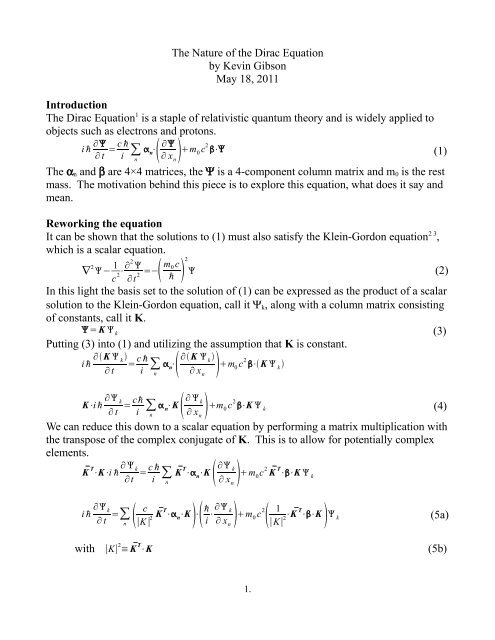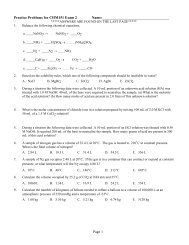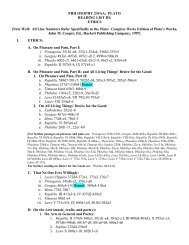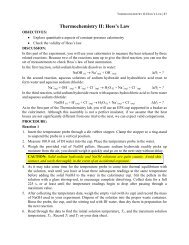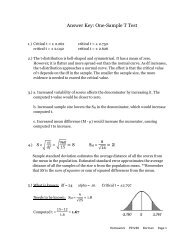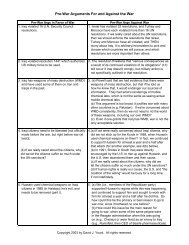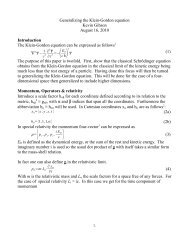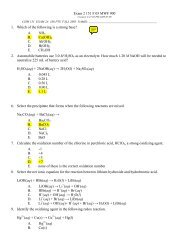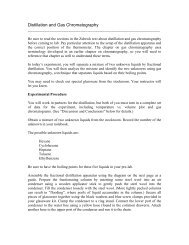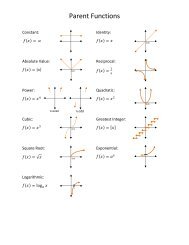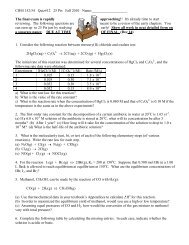The Nature of the solutions to the Dirac Equation ans spin
The Nature of the solutions to the Dirac Equation ans spin
The Nature of the solutions to the Dirac Equation ans spin
You also want an ePaper? Increase the reach of your titles
YUMPU automatically turns print PDFs into web optimized ePapers that Google loves.
i ħ ∂∂ t = c ħi∑ n⋅n<strong>The</strong> <strong>Nature</strong> <strong>of</strong> <strong>the</strong> <strong>Dirac</strong> <strong>Equation</strong>by Kevin GibsonMay 18, 2011Introduction<strong>The</strong> <strong>Dirac</strong> <strong>Equation</strong> 1 is a staple <strong>of</strong> relativistic quantum <strong>the</strong>ory and is widely applied <strong>to</strong>objects such as electrons and pro<strong>to</strong>ns.∂∂ x n m 0 c2 ⋅ (1)<strong>The</strong> α n and β are 4×4 matrices, <strong>the</strong> Ψ is a 4-component column matrix and m 0 is <strong>the</strong> restmass. <strong>The</strong> motivation behind this piece is <strong>to</strong> explore this equation, what does it say andmean.Reworking <strong>the</strong> equationIt can be shown that <strong>the</strong> <strong>solutions</strong> <strong>to</strong> (1) must also satisfy <strong>the</strong> Klein-Gordon equation 2 3 ,which is a scalar equation.∇ 2 − 1 c 2⋅∂2 ∂t =− m 20 c2 ħ (2)In this light <strong>the</strong> basis set <strong>to</strong> <strong>the</strong> solution <strong>of</strong> (1) can be expressed as <strong>the</strong> product <strong>of</strong> a scalarsolution <strong>to</strong> <strong>the</strong> Klein-Gordon equation, call it Ψ k , along with a column matrix consisting<strong>of</strong> constants, call it K.= K k (3)Putting (3) in<strong>to</strong> (1) and utilizing <strong>the</strong> assumption that K is constant.i ħ ∂ K k= c ħ ∑ ∂ t i n⋅ ∂K kn ∂ x n m 0 c2 ⋅ K k n⋅K ∂ k∂ x n m 0 c2 ⋅K k (4)K⋅i ħ ∂ k= cħ ∑∂ t i nWe can reduce this down <strong>to</strong> a scalar equation by performing a matrix multiplication with<strong>the</strong> tr<strong>ans</strong>pose <strong>of</strong> <strong>the</strong> complex conjugate <strong>of</strong> K. This is <strong>to</strong> allow for potentially complexelements.K T ⋅K⋅i ħ ∂ k= c ħ ∑∂t i nK T ⋅ n⋅K ∂ k∂ x n m 0 c2 K T ⋅⋅K ki ħ ∂ k∂ t = ∑n c∣K∣ 2with ∣K∣ 2 ≡ K T ⋅KK T ⋅ n⋅K ⋅ ħ i ⋅∂ k∂ x n m 0 1c2∣K∣ 2⋅ K T⋅⋅K k (5a)(5b)1.
<strong>The</strong> portions <strong>of</strong> (5a) contained in <strong>the</strong> paren<strong>the</strong>ses are in fact scalars. With <strong>the</strong>appropriate substitutions this can be re-written as:i ħ ∂ k∂ t = V⋅ ħi ⋅ ∇ k m 0 c2 k (6a)V n= c∣K∣ 2⋅ K T ⋅ n⋅K (6b)= 1∣K∣ 2⋅ K T ⋅⋅K (6c)At this point <strong>the</strong> matrix equation (1) has been tr<strong>ans</strong>formed in<strong>to</strong> scalar equation (6a). Asstated above Ψ k must be a solution <strong>to</strong> <strong>the</strong> Klein-Gordon equation, <strong>the</strong>refore equation(6a) can be viewed as a boundary condition <strong>to</strong> be satisfied on (2). But what does Kmean? Thus far <strong>the</strong>re are two things that can be deduced. First, it is needed <strong>to</strong> interface<strong>the</strong> scalar Ψ k in<strong>to</strong> (1). Second, it influences <strong>the</strong> boundary condition (6a). Yet <strong>the</strong>re isstill more <strong>to</strong> be learned.Connecting <strong>to</strong> relativityBefore exploring K some non-quantum mechanical physics needs <strong>to</strong> be explored. <strong>The</strong>mass-shell relationship is 4E 2 =c 2 p 2 m 0 c 2 2 (7)This can be linearized using <strong>the</strong> standard equations for relativistic energy andmomentum 5 .m 0 c 2 E=c 2 m 0 u ⋅pm 0 2 c 4E=u⋅pm 0c 2 ⋅ 1 For energy, momentum eigenstates states (6a) and (8) are compatible with twoassumptionsV u 1 (8)(9)2.
<strong>The</strong> nature <strong>of</strong> <strong>the</strong> solutionSo what is <strong>the</strong> significance <strong>of</strong> <strong>the</strong> elements <strong>of</strong> K? To determine this substitute <strong>the</strong>standard expressions for α n and β in<strong>to</strong> (6a) and (6b). This givesV 1= 2c∣K∣ 2⋅ R K 1K 4R K 2K 3 (10a)V 2= 2c∣K∣ 2⋅ R K 1K 3−R K 2K 4 (10b)V 3= 2c∣K∣ 2⋅ I K 1K 4−I K 2K 3 (10c)= ∣K 1∣ 2 ∣K 2 ∣ 2 −∣K 3 ∣ 2 −∣K 4 ∣ 2= 1∣K∣ 2(10d)<strong>The</strong> conclusions are interesting.● Because <strong>of</strong> (10d), states where K 1 and K 2 are <strong>the</strong> only nonzero elements representpositive energy while states where K 1 and K 2 are <strong>the</strong> only nonzero elementsrepresents negative energy.●●An examination <strong>of</strong> equations (10a) <strong>to</strong> (10c) shows that states with only one nonzeroelement <strong>of</strong> K will represent a state at rest.In order for <strong>the</strong>re <strong>to</strong> be motion one needs <strong>to</strong> have ei<strong>the</strong>r K 1 or K 2 as a non-zeroelements and ei<strong>the</strong>r K 3 or K 4 as a non-zero elements.Because motion in a particular direction, ala (10), does not depend on a single element<strong>of</strong> K, it cannot represent a vec<strong>to</strong>r, at least not in space-time.3.
<strong>The</strong> state <strong>of</strong> <strong>the</strong> UnionAn interesting consequence arises from <strong>the</strong> third bullet point above. Consider threescenarios below.K matrix Γ Energies1K =K 1 E = m 0 c 200=00K04-1 E = -m 0 c 20K1K =K 040K-1≤Γ≤1 |E| ≥ m 0 c 2Table 1.A state with both K 1 and K 4 elements will be in motion and so will have a positiveenergy greater than its rest energy or a negative energy less than its negative rest energy.A conceptual conflict arises if we envision each element <strong>of</strong> K as a separate state. <strong>The</strong>reason for <strong>the</strong> conflict is that if K 1 and K 4 represent states <strong>the</strong>n <strong>the</strong> third state in <strong>the</strong>above table should constitute a mixture <strong>of</strong> positive and energy states and so having anenergy∣E∣≤m 0 c 2 (11)should be possible. However it is not. It is <strong>the</strong>refore logically inconsistent <strong>to</strong> assign astate <strong>to</strong> each element. All that one can say is that a particular configuration <strong>of</strong> K leads <strong>to</strong>a particular state.SpinIn <strong>the</strong> literature <strong>the</strong> first and third elements <strong>of</strong> Ψ are assigned <strong>to</strong> <strong>the</strong> <strong>spin</strong> up states while<strong>the</strong> balance belong <strong>to</strong> <strong>spin</strong> down. However, as can be seen from <strong>the</strong> above arguments,this is a poor interpretation. <strong>The</strong> most that can be said is that a state with <strong>the</strong> onlynonzero elements being K 1 and K 3 can be assigned <strong>the</strong> label <strong>of</strong> “<strong>spin</strong>-up.” Likewisestates with only nonzero elements being K 2 and K 4 can be called “<strong>spin</strong>-down.” Howeversimply classifying o<strong>the</strong>r states as a mixture <strong>of</strong> <strong>spin</strong>-up and <strong>spin</strong> down is problematic.<strong>The</strong> difficulty lies in not being able <strong>to</strong> separate any Ψ in<strong>to</strong> <strong>spin</strong>-up and <strong>spin</strong>-down states.4.
<strong>The</strong> reason is that while K can be so divided <strong>the</strong> associated Ψ k from (3) cannot, for whenone divides K <strong>the</strong> associated Ψ k would have <strong>to</strong> changeSo what can be said about <strong>spin</strong> according <strong>to</strong> <strong>Dirac</strong>? According <strong>to</strong> <strong>the</strong> paradigm, <strong>the</strong><strong>Dirac</strong> equation shows <strong>spin</strong> as an intrinsic property 6 . However <strong>the</strong> derivation itself doesnot include any information about any <strong>of</strong> <strong>the</strong> intrinsic properties <strong>of</strong> <strong>the</strong> particle inquestion. Moreover this solution is said <strong>to</strong> be <strong>the</strong> solution for matter with two <strong>spin</strong>states, called <strong>spin</strong> ½ particles, while <strong>the</strong> Klein-Gordon equation is only valid forparticles without <strong>spin</strong>. Yet as was seen above <strong>the</strong> elements <strong>of</strong> Ψ cannot be assigned <strong>to</strong>specific states. Thus <strong>the</strong> question <strong>of</strong> what (1) says about <strong>spin</strong> is still left open and vaque.Connecting <strong>the</strong> <strong>Dirac</strong> and Klein-Gordon equations via (8) shows <strong>the</strong> underlying physicsbehind <strong>the</strong> derivations. Indeed both are extensions <strong>of</strong> (7). So whereas <strong>the</strong> Klein-Gordonis a second order scalar equation <strong>the</strong> <strong>Dirac</strong> is a first order matrix equation. Nei<strong>the</strong>requation contains nei<strong>the</strong>r extra information nor a deficit <strong>of</strong> information and so <strong>the</strong> twotell <strong>the</strong> same s<strong>to</strong>ry, thus demonstrating a weakness in <strong>the</strong> orthodox interpretation <strong>of</strong> <strong>the</strong>elements <strong>of</strong> Ψ.Works Cited1. http://en.wikipedia.org/wiki/<strong>Dirac</strong>_equation2. http://www.iitg.ernet.in/physics/fac/gsetlur/<strong>Dirac</strong>Eqn.pdf3. http://www.physics.ucdavis.edu/~cheng/teaching/230A-s07/rqm2_rev.pdf4. Paul A. Tipler and Ralph A. Llewellyn Modern Physics 4 th ed. p. 915. Kevin Gibson A new statistical view for elementary matter (unpublished)http://www.mesacc.edu/~kevinlg/i256/A_new_statistic.pdf6. G.E. Uhlenbeck and S. Goudsmit, Naturwissenschaften 47 (1925) 953Contact informationkevin.gibson@asu.edukevinlg@mesacc.eduwww.mesacc.edu/~kevinlg/i2565.


